
views
Preparing to Iron
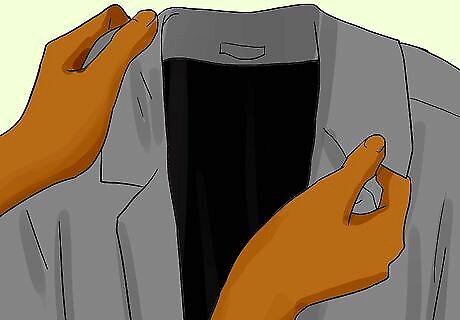
Check your jacket for stains. Pull out the jacket that you want to iron and check for any spots, sweat stains, or dirt. Heat will set in stains and make them much harder to remove, so treat any stains or spots before you iron.
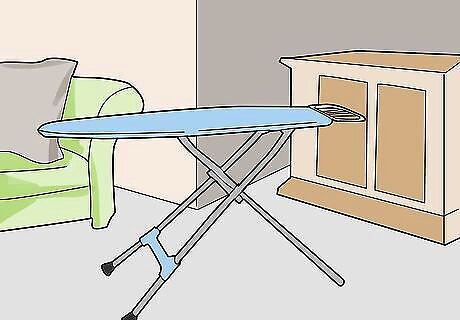
Set up the ironing board. If you don't have one, use a bath towel folded in half and lay it on a flat surface that will not be damaged by heat, like hardwood or a granite countertop. Your ironing board should be level and be close enough to an electrical outlet if your iron is not cordless. A regular ironing board works fine, though you can also use a thinner sleeve board. EXPERT TIP Susan Stocker Susan Stocker Green Cleaning Expert Susan Stocker runs and owns Susan’s Green Cleaning, the #1 Green Cleaning Company in Seattle. She is well known in the region for outstanding customer service protocols — winning the 2017 Better Business Torch Award for Ethics & Integrity —and her energetic support of green cleaning practices. Susan Stocker Susan Stocker Green Cleaning Expert Expert Trick: If you have one, try using a handheld steamer to remove wrinkles. In a pinch, dampen your hands with water and pat the wrinkles gently, then hang the jacket in the bathroom with the door shut while you run the shower. The steam will help dissolve the wrinkles.

Check the suit label. Look on the inside lining of your suit jacket for the care instructions and to see what material your jacket is made of. You will need to adjust the heat setting on your iron depending on the suit material. Here are some of the most common jacket materials and their heat settings: Linen or cotton: hot. Synthetic fabric like acrylic, nylon, or silk polyester: cool. Polyester blend, wool: cool-warm.
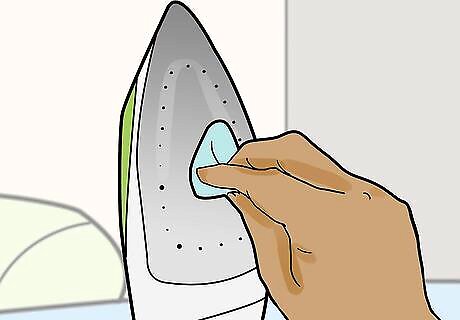
Make sure the iron is clean. The base of your iron can become dirty over time and leave residue on fabrics. If the base does need to be cleaned, use a damp cloth or a baking soda paste to remove tough stains. To make the paste, mix 1 tablespoon of water with 2 tablespoons of baking soda. Apply the paste and then wipe the iron clean after one minute.
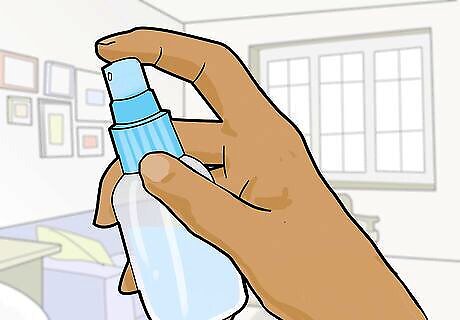
Fill a spray bottle. While you are ironing, you will need to spritz small amounts of water onto the fabric to prevent it from burning. The water also acts as a steam release to help smooth wrinkles. If your iron has a steam function, you will not need a spray bottle. Make sure to fill your iron with distilled water so the water is heated before you begin. Be sure to use distilled water since tap water can contain high amounts of calcium or minerals that will damage your iron over time.

Plug in your iron. Set the heat setting to reflect your jacket's materials. Allow the iron to heat up. This may take several minute depending on your iron. Most new irons will have an indicator light that will light up when the iron is hot. Do not begin until you are sure that the iron is at the correct temperature.

Place a cloth between the iron and your jacket. This will help to protect your suit as you iron it and helps to ensure that you won't create any shiny spots on your jacket. A cotton rag or towel will work fine, but a muslin or drill cloth is best. You will want to have a cloth between your iron and each part of the jacket that you are pressing. If you do not have a cloth, flip the jacket inside out and press the fabric through the lining. The lining of your jacket will likely be a different material than the rest of the suit fabric. Be sure to check the care instructions to see what material the lining is and adjust your iron's heat settings accordingly.
Ironing the Jacket
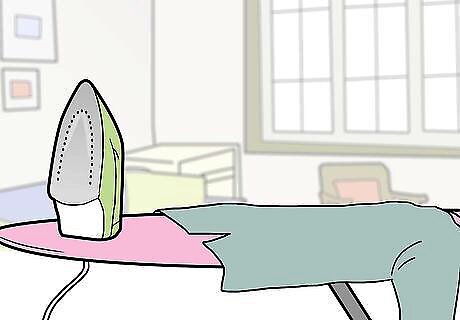
Take the jacket and lay it flat on the board. You'll want to lay the jacket with the back facing up so you can iron the back first. Test the iron heat first on an inside area of the fabric, close to the hem, so if for some reason the iron leaks or marks it, it is not in a visible place. Adjust the settings if necessary and continue carefully. Smooth out any large wrinkles before you begin pressing the jacket. If the jacket has any embroidery, turn the jacket inside out and press it through the lining rather than over the embroidery. You will need to use a cooler heat setting if you press through the lining.
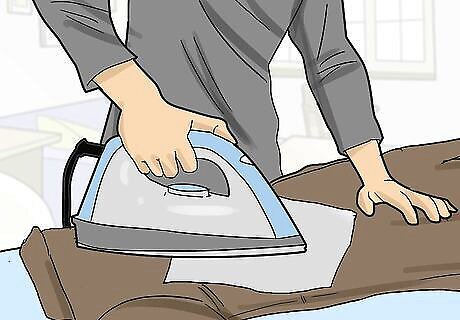
Press the back section. Lay the jacket flat on the ironing board with the back of the suit on top and facing you. Do not pull or stretch the arm seams while you are pressing the back of the suit since these should stay slightly shrunken. Spray a small amount of water onto the fabric you want to press. Press down on sections of the back rather than gliding the iron over the fabric. You want to press the wrinkles out rather than smoothing them. If the jacket has vents, put a piece of stiff paper between the vent and the rest of the back. This helps to prevent marks being made on the layer underneath the vent. Iron the top piece of the vent, then lift it up while you press the piece that is underneath the vent.
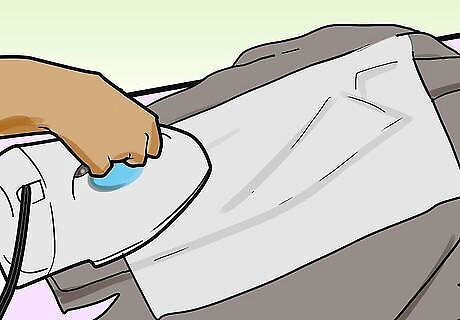
Flip the jacket to the front. Now that the back has been pressed, you can begin to work on the front and sides of the jacket. Lay one half of the jacket on the ironing board so the other half of the front is off the board. If the jacket has darts, the dart should be lined up with the outer edge of the board to avoid creasing. Smooth any large wrinkles out of the fabric and lining before you start to press and spritz the fabric with water.
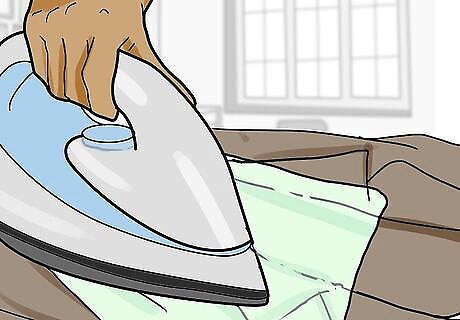
Press the front of the jacket. Press the front part of the jacket in small sections using a moderate amount of pressure. The front of the jacket will most likely have pocket flaps and lapels that you will need to pay special attention to. Jacket lapels should not be creased unless you want a hard military look. Run the iron over lapels very gently. Similarly, if the jacket has shoulder pads do not press directly on the pads or their outline will be pressed into the jacket. Pull out pockets before you press over that area so you do not press in the outline of pocket wrinkles. If there are pocket flaps, use the stiff piece of paper you used on the vents to separate the layers as you press them.
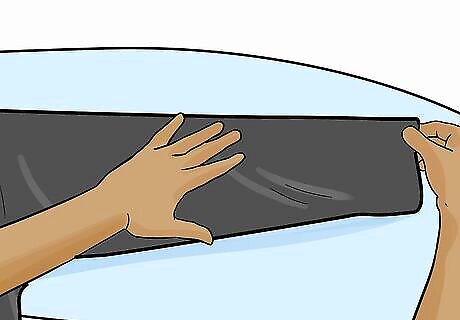
Prepare the sleeves. Sleeves are the trickiest part of the jacket to iron because of their shape and the fact that you have two layers of fabric and lining to deal with. Lay the sleeve down on the board and smooth out any large wrinkles in the fabric and the lining by hand. If you are using a sleeve board, insert the board into the sleeve so you can rotate the sleeve around the board. Lay a damp cloth over the sleeve. This will help to protect the suit fabric and make pressing easier.

Iron the sleeves. Start by ironing the center of the sleeve first. Use the arm seam to guide the iron so you do not crease the fabric. Using a sleeve board is the easiest way to iron a sleeve since you can rotate the material around the board as you press without creating a crease. If you do not have a sleeve board you can substitute a cylindrical container to keep the sleeve's shape while you iron. You can use a rolled up thick magazine or a cylindrical cardboard tube and insert it into the sleeve. Be sure to cover the magazine or tube with a cotton towel before you insert it.
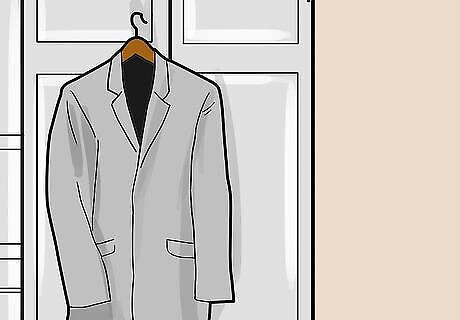
Hang up your jacket. As soon as you are finished, hang your neatly pressed and steamed jacket on a well-shaped hanger. Use a hanger with shoulders and padding if possible, though a wire one will work in a pinch. Allow the jacket to hang while it cools. Unplug your iron and put away your ironing board. Wait until the iron is cool to the touch before putting it away.



















Comments
0 comment